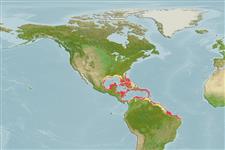>
Ovalentaria/misc (Various families in series Ovalentaria) >
Pomacentridae (Damselfishes) > Microspathodontinae
Etymology: Stegastes: Greek, stegastos, -e, -on = covered (Ref. 45335).
More on author: Poey.
Environment: milieu / climate zone / depth range / distribution range
Ecología
marino asociado a arrecife; no migratorio; rango de profundidad 0 - 100 m (Ref. 9626). Tropical; 33°N - 5°S, 98°W - 34°W
Western Atlantic: including southern Florida (USA), Bahamas, and the Caribbean. Probably extending to Brazil (Ref. 9626).
Tamaño / Peso / Age
Maturity: Lm ? range ? - ? cm
Max length : 10.0 cm TL macho / no sexado; (Ref. 26340)
Short description
Morfología | Morfometría
Espinas dorsales (total): 12; Radios blandos dorsales (total): 14-17; Espinas anales 2; Radios blandos anales: 13 - 15. Exhibits geographic color variations (Ref. 7247). Body dark in front, becoming abruptly yellow between last dorsal spine and anal fin origin (Ref. 26938).
Adults inhabit shallow coral reefs and isolated patch reefs in deeper water. Feed primarily on algae but also on polychaetes, hydroids, copepods and ascidians (Ref. 9626). Aggressively territorial but only around a small area (Ref. 9710). Oviparous, distinct pairing during breeding (Ref. 205). Eggs are demersal and adhere to the substrate (Ref. 205). Males guard and aerate the eggs (Ref. 205). Taken incidentally in traps and small-meshed beach nets (Ref. 5217).
Life cycle and mating behavior
Madurez | Reproducción | Puesta | Huevos | Fecundidad | Larva
Oviparous, distinct pairing during breeding (Ref. 205). Eggs are demersal and adhere to the substrate (Ref. 205). Males guard and aerate the eggs (Ref. 205). This species has a juvenile bisexual condition and a typical gonochore testis (Ref. 103751).
Allen, G.R., 1991. Damselfishes of the world. Mergus Publishers, Melle, Germany. 271 p. (Ref. 7247)
IUCN Red List Status (Ref. 130435)
Threat to humans
Harmless
Human uses
Acuario: Comercial
Más información
ReferenciasAcuiculturaPerfil de acuiculturaRazasGenéticaElectrophoresesheritabilidadEnfermedadesProcesamientoNutrientsMass conversion
Herramientas
Special reports
Download XML
Fuentes de Internet
Estimates based on models
Preferred temperature (Ref.
123201): 24.2 - 28, mean 26.9 °C (based on 262 cells).
Phylogenetic diversity index (Ref.
82804): PD
50 = 0.5000 [Uniqueness, from 0.5 = low to 2.0 = high].
Bayesian length-weight: a=0.01230 (0.00564 - 0.02686), b=3.06 (2.87 - 3.25), in cm total length, based on LWR estimates for this species & (Sub)family-body (Ref.
93245).
Nivel trófico (Ref.
69278): 2.0 ±0.00 se; based on food items.
Resiliencia (Ref.
120179): Alto, población duplicada en un tiempo mínimo inferior a 15 meses (Preliminary K or Fecundity.).
Fishing Vulnerability (Ref.
59153): Low vulnerability (10 of 100).
Nutrients (Ref.
124155): Calcium = 123 [65, 204] mg/100g; Iron = 0.889 [0.533, 1.467] mg/100g; Protein = 18.2 [17.1, 19.3] %; Omega3 = 0.157 [0.098, 0.256] g/100g; Selenium = 30.7 [16.8, 59.7] μg/100g; VitaminA = 111 [31, 375] μg/100g; Zinc = 2.37 [1.62, 3.37] mg/100g (wet weight);
